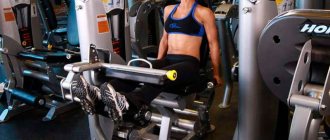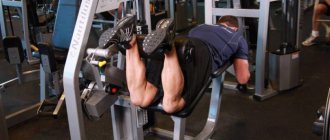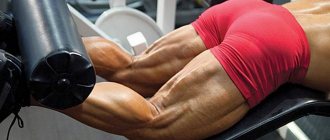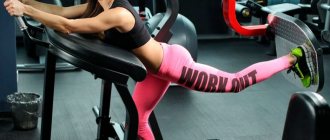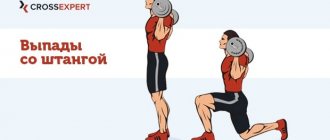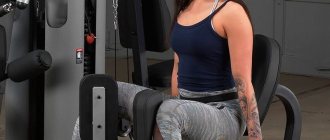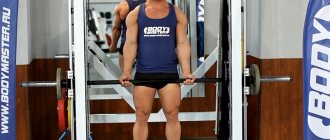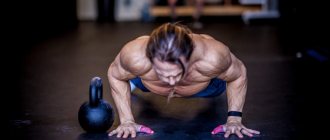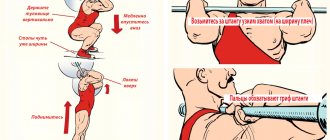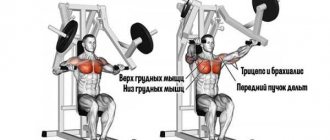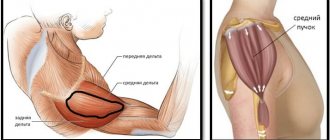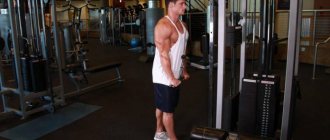The standing leg curl exercise pumps up the bottom (“peak”) of the thigh biceps, as well as the calf muscle. Lengthens the hamstrings. Isolation exercise.
In bodybuilding, standing leg curls are used to emphasize and push out the bottom (“peak”) of the hamstrings, making the thigh appear long and proportional (when looking at the leg from the side). This exercise also effectively defines the muscles of the back of the thigh, improving their definition and separation.
The standing leg curl is a very useful exercise for all sports that involve jumping, running and various kicking or kicking movements: football, basketball, gymnastics, athletics and karate.
Leg bending in a standing machine - exercises for leg muscles
What muscles are involved in leg curls in the machine?
As mentioned earlier, leg curls in the simulator are aimed at working the back of the leg. The so-called biceps femoris or biceps femoris. Call the muscle whatever you like. The main thing is that you have an understanding of what it looks like, where it is located and what functions it performs. But the biceps does not receive all the load; there are also assistant muscles.
- Biceps femoris muscle . Is the target muscle that performs 90% of the movement. It is located on the back of the thigh, just below the gluteal muscles. It is called double-headed because it has two beams: long and short. They are both involved in the exercise. Its functions: bending the lower leg, moving the leg back, and turning the toes apart from each other.
- Semitendinosus muscle . It is located on the back of the thigh closer to the inner (medial) edge. It is an assistant muscle that helps bend the lower leg. Its outer edge borders the biceps muscle, and the inner edge borders the semimembranosus muscle. Its functions are the same as the hamstrings, except for turning the toes. She rotates them inward, towards each other
- Semimembranosus femoris muscle . It is located very close to the inner edge of the thigh. Most of it is covered by the semitendinosus muscle. There are three bundles: outer, middle and inner. Main function: the same as the others, but is not involved in turning the toes.
- Calf muscle . The last muscle involved in the movement is the calves. It is located on the back of the lower leg. It has two heads, internal and external. Function: stabilizes the feet during lifting, and also works during leg extension, creating resistance.
These 4 muscles work in this exercise, and it is their development that gives the back of the leg a beautiful shape.
A set of crossover exercises
We asked Victoria Tyazhina to compose and show us a set of exercises in a crossover, which is aimed at working the main muscle groups.
How to build a lesson
- Start your workout with a short warm-up.
- Perform the exercises sequentially: 3-4 sets of 12-15 repetitions each. “If we are working with large muscles (buttocks, hips, back), then we can do 4 approaches, they need to be “squeezed” thoroughly. And if we work, for example, with the shoulders, then 2-3 approaches will be enough,” adds Victoria Tyazhina.
- Finish your session with stretching to relieve tension in your major muscle groups.
- Do this program 2-3 times a week. “Here it all depends on experience: I don’t advise beginners to exercise more than twice a week, so as not to “burn out,” comments Victoria Tyazhina. “More experienced athletes can train 3-4 times a week.”
Choose weights so that the last 2-3 repetitions of the approach require maximum effort from you.
To complete the complex you will need a crossover and a set of handles for it.
Taking your leg back diagonally
1-swing legs diagonally
Attach the cuff to your right ankle. Stand with your left side facing the crossover, your feet parallel to each other, and rest your left palm on the rack of the machine. Lean your body forward slightly. Don't slouch, maintain a natural arch in your lower back. Place your right hand on your belt. Take your right foot back and swing diagonally to the right, stretching the cable more. Perform 12-15 repetitions on each side. Do 3-4 sets of exercises.
Squats with a lower block
2-squats with a lower block
Attach the handle to the lower block. Stand up straight, grab the handle of the crossover so that your arms are extended. Place your feet parallel to the width of your pelvis. You can turn your socks outward. Move your pelvis back, as if “hanging” on the cable of the exercise machine. Bend your knees, push your pelvis back as far as possible and lower yourself into a squat. Tilt your body slightly forward. Actively work the muscles of your legs, buttocks and back. Then straighten your knees and return to a vertical position. This is one repetition, do 12-15 of these . Do 4 sets of the exercise.
Hip extension
3-Hip extension
Place a bench in front of the crossover. Attach the cuff to your right ankle. Place your body on the bench so that your knees are under your pelvis and your palms are under your shoulders. Do not increase the arch in the lower back, do not slouch, stretch forward with the top of your head. Bend your right knee toward your chest, then extend your right leg back, pointing your toe toward you. This is one repetition, do 12-15 of these in each direction. Do 3 sets of the exercise.
Standing calf curl with lat pulley
4-Standing calf flexion with lower block
Instead of a handle, attach a cuff to the cable, then put it on your right ankle. Stand facing the simulator stand at a distance of 30-40 cm, lean on it with your hands. Stand straight with your knees and feet together. Transfer your body weight to your left foot, bend your right knee and move your foot back, stretching the cable of the machine. Point your right heel towards your buttock. Don't slouch and maintain a natural arch in your lower back. This is one repetition, do 12-15 of these in each direction. Do 3 sets of the exercise.
One-arm horizontal row
5-Horizontal thrust
Attach the classic handle to the cable. Stand facing the rack of the machine, place your left foot slightly forward. Distribute your weight between both feet. Do not slouch or increase the arch in your lower back. Place your left hand on your thigh. Grasp the crossover handle with your right palm (arm extended) and pull it towards you, bending your elbow. Work the muscles of your back and arms. Then extend your arm, returning to the starting position. This is one repetition, do 12-15 of these in each direction. Do 3 sets of the exercise.
Two-arm horizontal row
6-horizontal row with both hands
Attach a long pulley handle to the cable of the upper block. Stand facing the rack of the machine, place your feet parallel to each other, shoulder width apart. Grasp the edges of the handle with both palms. Move your pelvis back and lean your body forward. Stretch your arms up, holding the handle of the machine. Smoothly lower your straight arms down, stretching the cable and bringing the handle closer to your hips. Finally, bend your elbows and pull them closer to your groin. Actively work the muscles of your back, arms and abs. Do not increase the arch in the lower back, direct your gaze forward and down. This is one repetition, do 12-15 of these. Do 3 – 4 sets of exercises.
Pullover standing
7-pullover
Attach a long pulley handle to the cable of the upper block. Stand facing the rack of the machine, place your feet parallel to each other, shoulder width apart. Grasp the edges of the handle with both palms. Move your pelvis back and lean your body forward. Stretch your arms up, holding the handle of the machine. Smoothly lower your arms down, stretching the cable and bringing the handle closer to your hips. Actively work the muscles of your back, arms and abs. Do not increase the arch in the lower back, direct your gaze forward and down. This is one repetition, do 12-15 of these. Do 4 sets of the exercise.
Lower pulley to the chin
8-thrust of the lower block
Stand facing the rack of the machine, place your feet parallel to each other, shoulder width apart. Grasp the edges of the handle on the lower block with both palms and extend your arms. Do not slouch or increase the arch in your lower back. Bend your elbows and pull the handle up, almost to chin level. Point your elbows out to the sides and up. Work the muscles of your arms, abs and back. Then slowly lower your arms, returning to the starting position. This is one repetition, do 12-15 of these. Do 2–3 sets of exercises.
Lifehack
There are several techniques that can shift the direction of the load. These are proven facts that really work. It consists of turning the socks around:
- If you turn your toes to the sides, the load will shift to the inner thighs. That is, on the lateral (external) bundle of the biceps muscle. In principle, this is expected, because its function includes reversing the stops.
- Therefore, bringing your toes inward will also change the emphasis to the inner thigh. That is, on the semimembranosus and semitendinosus muscles.
Of course, you need to understand that these changes are minimal and you can hardly expect a big result from them. But you can and even need to use them. This will help work the back of the thigh under a variety of vectors. Which will have a beneficial effect on overall growth.
Exercise options
Due to increasing progress and various experiences in the field of anatomy and the effects of exercise on muscles, it has been proven. That the hip can work in several planes. Standing, sitting and lying down. Therefore, various exercise machines have been developed and we can choose the one in which our muscles work maximum.
Leg bending in a lying machine
It’s not for nothing that I mentioned this option first. This is because he is very famous in many halls. I think you won’t ignore it either. There are several types of simulator, but in principle they all perform the same function. They can be divided according to the type of bench: horizontal and curved. And also by type of loading: cable with weights and regular with pancakes. In principle, there is no big difference between them. But it is still better to give preference to a curved bench. Its shape helps achieve maximum insulation. At the same time, your pelvis is raised slightly upward. This allows for a stronger stretch of the thigh muscles at the bottom. Consequently, they will receive a much greater load, and this will only increase their growth rate.
Initial position:
- Go to the simulator. Set it to the weight you need (set the weights or set the limiter to the weight you need).
- Lie on a leg curl bench with your knees extending beyond the edge of the bench. If you have a horizontal bench, then lift your pelvis up a little.
- Place your feet under the special roller of the machine. It should be located above the heels. Grasp the handles with your hands.
Leg bending while sitting in a machine
The sitting option is also very famous. It is especially common during training in the “Superset” style. This is when you do several exercises in a row in one approach without rest. Basically, they choose to do leg extensions while sitting on the quadriceps, and then immediately do curls in the same machine. This is very convenient because you don’t have to run around the hall. But if we are talking about ordinary linear training, then bending the legs while sitting is inferior to the lying option. All because of the inconvenience of the simulator itself. Firstly, to prevent you from being thrown up by the weight of the weight, a special roller presses on your legs from above. Sometimes, of course, it fits perfectly in terms of the amount of lift. But in most cases, it either squeezes the legs or, on the contrary, goes too high. Secondly, it is very difficult to focus on the work of the biceps muscles. This is because during bending you will need to move your pelvis forward a little to feel the hamstrings and increase the range of motion. And as you know, if you do two things at once, which one will lag behind. Conclusion: if you train using the superset system, or you don’t have another machine in the gym. Then the sitting option will be a good helper for you.
Initial position:
- Once you have set the weight you need, sit on the machine. Rest your back against the backrest.
- Place your feet on the bolster. So that it is under the calf muscles closer to the heel. Your knees should extend beyond the edge of the seat. Place a bolster on top to hold your legs. It should be located just above the knee joints.
- Lean back and grab the special handles with your hands.
Standing leg curl in the simulator
This is the technically simplest version of leg curls. But unfortunately its popularity is quietly fading. Nowadays, not many medium-sized gyms can boast of having such a machine where you can do leg curls while standing. And this news is very disappointing, because there are a lot of advantages in this option.
- Maximum hamstring isolation.
- Large range of motion, and this, as we remember, has a beneficial effect on muscle growth.
- The back is completely excluded from the exercise, so it will be easy for both beginners and professionals. And also for people with back injuries, of course not significant.
- Working on each thigh separately. Of course, this can be done in the other two options, but they will not be as convenient.
You can see how many positive points can be highlighted in this exercise. But of course there are several disadvantages. If you work your legs separately, it will take twice as long. And due to the fact that now time is a very important resource, many simply do not have enough of it. Therefore, more and more people are abandoning one-sided training.
Initial position:
- Set the desired weight. Place one of your legs (right or left) under the cushion. Just like everywhere else, it should be below the calf muscles. Place the knee of the same leg against the lower movable platform. Place your other foot on the floor.
- Grasp the handles with your hands. Some simulators provide special supports for the elbows and torso.
Execution technique
Execution technique is a very important component of any exercise. It is thanks to correct execution that we achieve maximum contraction of the muscles we act on. We also protect ourselves from various injuries. Leg bending in a machine, regardless of which option you choose, is technically performed the same way.
- After you have taken the starting position. As you exhale, bend your legs(s) at the knee. And bring the roller to the pelvis. Trying to reach the gluteal muscles with your heel. Take a short break at the top
- Next, as you exhale, straighten your legs and return to the starting position.
- Repeat the specified number of times. If you did the standing version, change your leg and do the same on it.
Video of performing the lying option:
Video of performing the sitting option:
Video of performing the standing option:
The technique is very simple. But you still need to keep an eye on her
Tips for Maximum Productivity
- Do not straighten your knees completely in the lower position. You should try to keep your muscles constantly tense. This will give them additional stress and minimize the chance of injuring your knee.
- Place the machine so that your knees do not rest against the bottom edge of the bench, or against the bolster in the seated version. This way they will not receive vertical load.
- When lifting, you do not need to help yourself with your body. That is, do not throw the roller using the pelvis and lower back. You will only make things worse and will never tone your hamstrings.
- Watch the position of the roller. It should be located exactly in the area between the heels and the end of the calf muscles. There is no need to place it on your heels, this will shift the emphasis to the calf muscles.
- Perform this exercise at the end of your leg workout. This will help to maximally load the biceps muscles, which are already tired after basic exercises.
- Work through the full range of motion.
- At the top point, take a short break. This will give a peak contraction to your muscles.
- At the end of your workout, do some hip stretches. This will improve blood circulation.
- Do not rotate your feet during the exercise. Also, maintain the position of your legs relative to each other. Then the muscles will receive the proper load.
Necessary equipment
To adduct the hip, you need a crossover - a special simulator designed for professional bodybuilding. It has a stable metal structure that can withstand heavy loads. On such a simulator you can perform various exercises to pump muscles using upper and lower blocks.
To make muscle contractions more effective, you can also use special leg weights that are attached to the ankle. They can be made in the form of cuffs or bracelets filled with sand and have different weights - from 1 to 5 kg. This attribute can increase the load, which will speed up the pumping of the necessary muscles, and will also help to quickly build muscle tissue.
Don't forget about such an important detail as clothing. It should be breathable, lightweight, not restrict movement and made from natural materials. Sweat that accumulates on the body under low-quality synthetic T-shirts and T-shirts can cause allergies, itching and redness, which will distract from activities and cause inconvenience.
The ideal clothing option for bodybuilding would be professional thermal underwear, which is designed for sports, so it will not cause discomfort during training.
Basic errors during execution
When it gets to this point, many builders start saying, “This is not about me.” My technique is perfect, etc...." If this is indeed the case, then congratulations. But even in this case, this information may be useful to you. After all, there are a lot of people in the halls who have not yet achieved mastery. And our task is to help them avoid these mistakes!
Heavy weight
This is one of the common mistakes. This is all due to the fact that people overestimate their strength and want to achieve results as quickly as possible. But this approach can only lead to injury and delay progress. Therefore, take a weight that you can safely work with for 10-15 repetitions. And as you feel that you are ready for heavier loads, you can add weight.
Bending jerkily and lifting by inertia
This error follows smoothly from the first. When an athlete cannot cope with the weight, he begins to use the force of inertia. In fact, it looks very terrifying. At the beginning, the legs fall sharply with the load down, and then when they spring back, they are sharply squeezed up. I think it’s clear what consequences this can have. Take care of your knees! Movements must be under your control.
Body displacement during movement
Many athletes have this peculiarity: in order to reduce their fate, they begin to reduce the amplitude of movement. They do this very simply, changing their position on a bench or in a standing exercise machine. That is, they either slide down or, on the contrary, creep up. This changes the position of the roller on the legs. I wrote above that if you shift the weight to your heels, the load goes to your calves. And if you put the roller on your calves, the range of movement will become very short. Therefore, neither option will work the hamstrings.
Good luck to everyone in your training!
Lying leg curl[edit | edit code]
Lying leg curl on a machine
Lying leg curl belongs to the category of isolating exercises, since here only the knee joints are moved. As a result, this exercise uses only the back muscles of the thighs and partly the muscles of the legs.
Performance
Lie face down on the machine and secure your ankles under the moving frame. Using the back muscles of the thighs, bend your legs, bringing the frame towards your buttocks. Hold the top position for 2 seconds, keeping the muscles tense. Then straighten your legs, but not completely. Repeat the exercise.
Advantage
- Isolates the posterior thigh muscles, which allows you to better feel these muscles, the work of which can be difficult to feel under normal conditions.
Flaw
- In some cases, when the leg muscles are not well isolated, a burning sensation begins to be felt in the shin muscles earlier than in the posterior thigh muscles.
As you tighten your hamstrings, you'll want to arch your lower back and lift your butt. But this should not be done so as not to injure the spine.
Recommendations
- Perform the exercise slowly, with full control of your movements: they should not be sudden or explosive. Do not straighten your legs completely to keep the muscles tense.
- The position of the toes plays an important role in the contraction of the posterior thigh muscles. Pull your toes toward your knees and you'll activate your lower leg muscles and hamstrings more effectively, allowing you to handle more weight. Pull your toes out and minimize the work of your calf muscles. This variation with more muscle isolation will reduce your strength. To better utilize your toe position, start curling your legs with your toes pointed. When you feel tired, pull your toes towards your knees. This will engage the muscles in your lower legs, which will give you the strength to do a couple extra reps. • When you arch your back by bending your legs, your strength increases, but this compresses the intervertebral discs of the lumbar spine. This is why curved bench machines are safer: they support your spine without allowing you to arch your back too much.
Options on simulators[edit | edit code]
Leg bending while standing on a machine
- Some machines have flat benches, while others have curved benches. Exercise machines with a curved bench are more comfortable. In addition, they will allow you to work more effectively with the posterior thigh muscles, better protecting your lower back.
- On some machines, leg curls are performed in a standing position. This variation differs from the lying leg curl only in that here you train one leg at a time.
Option with your own body weight[edit | edit code]
- Lying leg curls can be performed on a bench or on the floor. However, keep in mind that your own body weight does not provide sufficient load.
- To perform a more effective version of the bodyweight leg curl, have a partner hold your feet while you lean forward. Starting position for this exercise: stand with your knees on a gymnastics mat.
- Lying leg curl with your own body weight
- clone forward on the knees (for the back of the thigh muscles)
Lying leg curl with your own body weight
Options with dumbbells[edit | edit code]
Holding a dumbbell between your legs will make this exercise more effective. It will become even more effective if performed on an incline bench.
Lying leg curl with dumbbell
FREE WEIGHTS OR MACHINES?
Lying leg curls can be performed by holding a dumbbell between your legs with an elastic band or cable machine attached to your ankles. However, leg curl machines are safer and easier to use.
